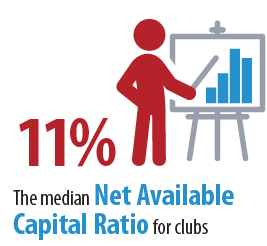 According to data from Club Benchmarking, the median Net Available Capital Ratio for clubs is 11 percent. However, just like any other data point, this statistic must have context before it can be put to work in the decision-making process. Like Plato said, “A good decision is based on knowledge and not on numbers.” Capital will be used to illustrate the power of putting data into context.
According to data from Club Benchmarking, the median Net Available Capital Ratio for clubs is 11 percent. However, just like any other data point, this statistic must have context before it can be put to work in the decision-making process. Like Plato said, “A good decision is based on knowledge and not on numbers.” Capital will be used to illustrate the power of putting data into context.
Total Capital Income
Total Capital Income, a critical number for club leaders to know, is the income from all capital sources i.e., initiation fees, capital dues or assessments, sale of property, investment income or any operating surplus. It’s a single data point represented as a dollar figure. This figure is only meaningful if you know how much you need.
Net Available Capital
The next step in converting data into knowledge is using Total Capital Income to calculate Net Available Capital, which is the amount of capital available for investment or debt reduction after factoring in the net operating result and lease payments. Clubs with relatively low Net Available Capital must determine whether low Total Capital Income causes the weakness or because capital is being cannibalized to bolster operating deficits. Consistently strong available capital has a cumulative positive effect on a club by allowing continuous investment in the club (aka value creation). Consistently weak Net Available Capital has a negative effect over time which manifests as outdated and poorly maintained facilities and amenities.
 Net Available Capital Ratio
Net Available Capital Ratio
The Net Available Capital Ratio (net available capital as a percentage of total operating revenue) is a critical key performance indicator for clubs. It measures the capital generation power of the club in relation to its size which indicates a club’s ability to build and deliver member value over time. The ratio expresses the amount available for capital Investment, debt reduction and increasing reserves, prior to debt principle payment. As shown in the chart below, the median Net Available Capital Ratio in the club industry is 11 percent. A study of the correlation between that ratio and key measures such as operating result, turnover and initiation fees shows that “capital rich” clubs are healthier overall. To learn more, watch a video at clubbenchmarking.com/value-creation.


